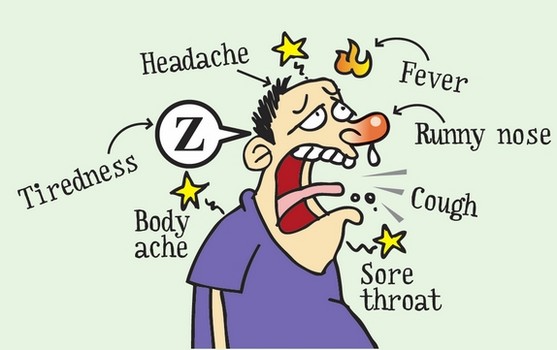Influenza, or more commonly
referred to as the flu, is a highly contagious virus that affects the
respiratory system. Because it is so contagious, it can affect thousands of
people annually. In fact, somewhere between 5% and 20% of the United States
population will contract the virus each year (2). However, despite its
frequency of occurrence, the flu is not always a deadly disease. Of the people
who are infected, there is an average of 200,000 hospital visits a year, and,
depending on the strain, the number of flu-related deaths can range from 3,000
to 49,000 (2). The following fact is what makes the flu so dangerous though:
the virus mutates every year. Every year doctors scramble to create a vaccine
that will protect the public from the different flu strains that hit during flu
season; they do not always make the appropriate vaccine, though, and that is
when fatalities can accumulate. This leads to a pandemic.
 The most recent influenza pandemic
was the H1N1 virus that occurred in 2009. Also known as swine flu, this virus
hospitalized thousands; everyone was caught off guard. On top of that,
scientists found that symptoms varied drastically among similar individuals
with the swine flu. Some people experienced no symptoms while some were
hospitalized. This has shown with the other strains of influenza as well, and
this was a question that scientists desperately were trying to find an answer
to: What decides whether one is going to be asymptomatic? After the onset of
the swine flu in 2009, a group of researchers at Imperial College London began
a study hoping to answer this question, and the results that they found were
groundbreaking.
The most recent influenza pandemic
was the H1N1 virus that occurred in 2009. Also known as swine flu, this virus
hospitalized thousands; everyone was caught off guard. On top of that,
scientists found that symptoms varied drastically among similar individuals
with the swine flu. Some people experienced no symptoms while some were
hospitalized. This has shown with the other strains of influenza as well, and
this was a question that scientists desperately were trying to find an answer
to: What decides whether one is going to be asymptomatic? After the onset of
the swine flu in 2009, a group of researchers at Imperial College London began
a study hoping to answer this question, and the results that they found were
groundbreaking.
In the experiment, Ajit Lalvani and
his colleagues recruited 342 participants and followed them during the course
of the second H1N1 outbreak in the 2010-2011 season. If they contracted the
virus and were originally seronegative for H1N1 antibodies, they were to fill
out symptom surveys. This allowed Lalvani and his colleagues to look at these
individuals at a molecular level to figure out immunological sources for the
different viral responses. They obtained their results by measuring the
frequencies of crossreactive T-cells in relation to illness severity as well as
symptom severity. They also correlated levels of CD8+IFN-γ+IL-2-
cells (a type of CD8 T cell), and symptom severity. Essentially, they were
looking at and quantifying the pre-existing T cell responses to the H1N1 virus
compared to the conserved core protein epitopes, as they were researching the
possibility of protective ability within T cells and its application to pandemic
influenza.
In their results, they found that
higher frequencies of the certain type of crossreactive T cell (CD8+IFN-γ+IL-2-)
were related to fewer and less severe flu symptoms and decreased or no viral
shedding. Similarly, they found that T cell responses to the conserved CD8
epitopes from three different immune-dominant core proteins (PB1, M1, NP) also
corresponded with reduced symptoms and severity. Consequently, from these
findings the researchers hypothesized that cellular heterosubtypic immunity may
be the reason for the symptomatic differences in those with H1N1. They also
theorized that the heterosubtypic immunity may alleviate the serious effects of
other disease-inducing viruses. Thus, the amount of certain CD8
T-cells is indirectly correlated to illness severity.
Despite these results, it should
be acknowledged that there were several limitations and flaws to this
experiment that may or may not affect the conclusions that were made. First of
all, the study was done during the second wave of H1N1 virus and not the first
due to waiting for ethical approval. The consequences of performing the
experiment after the initial H1N1 wave were that the sample size decreased and
the confidence intervals increased. However, they still found their data
consistent albeit smaller across the board. Lalvani and his colleagues also
realized that they could not compare the normally healthy individuals they
studied to high risk individuals, but there is a chance the data would still be
similar. They also did not measure the role of systemic innate immune responses,
only the role of cellular immune responses.
Still, based on these studies, scientists
could potentially create a universal flu vaccine for the public. In fact,
Lalvani himself said that researchers already know how to stimulate CD8 T-cell
creation via vaccine, so it is likely that scientists are now currently using
the findings in this paper and experimenting to create a universal vaccine (3).
The result of those studies, if successful, could then decrease flu-induced
hospital visits and possibly eliminate fatalities (3). It would also be
cost-effective, for a lot of money goes into flu vaccine production each year,
considering the flu virus mutates every season. Lastly, with a universal
vaccine, other viral diseases could attract even more attention. More resources
could go to finding universal vaccines for other viruses, which in turn will
help millions. These findings are the first step towards a new
kind of medicine, and we can only wait and anticipate the medical breakthroughs
that doctors, scientists, and researchers will have in the future.
Primary Source:
1. 1.. Sridhar, Saranya et. al. Cellular Immune
Correlates of Protection Against Symptomatic Pandemic
Influenza. 22
September 2013. Nature Medicine. Online Publication.
Other Sources:
2.Flu Information:
3. Interview with Ajit Lalvani/ Quick Information
about Paper:
Picture:
No comments:
Post a Comment